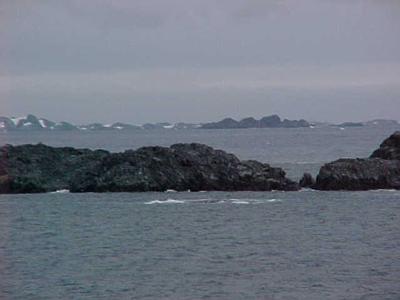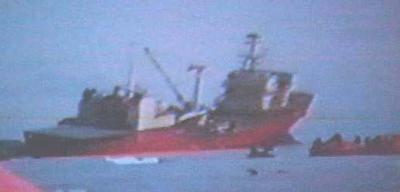1 April, 2000
Bahia Paraiso
Question 42: How can you convert Celsius to Fahrenheit and vice versa?
Just visible above the surface of the water next to DeLaca Island is the
smooth curve of what looks like a whale. But it doesn't move. It is actually
a tiny portion of one of the southernmost shipwrecks. One that is only a mile
from the station.
On the 28th of January 1989, the Argentinean supply/cruise ship Bahia Paraiso
ran aground after leaving Palmer Station. At almost 500 feet long, the Bahia
dwarfs both the Gould and the Palmer. She is now resting on her starboard
side parallel to the west side of DeLaca Island. For several days after she
ran aground on a rocky pinnacle, she stayed stuck on it, only slightly tilted.
Rough stormy weather eventually came in; and five days after the shipwreck,
the Bahia slipped off the pinnacle, came around the island and turned over
onto her side. The rest of the sinking process took place gradually over the
next few months, and for quite some time portions of the deck were still above
water.
The Bahia was carrying nearly 100 tourists that had just been ashore at
Palmer Station for a tour. The ship ran aground at 2 pm, and by midnight all
of the tourists had been picked up by other cruise ships in the area. Within
24 hours of the wreck, they were on land at Marsh Base (Chilean) on King
George Island preparing to fly home. The almost 200 crew members (ship crew
as well as change-over personnel for Argentinean bases in the area) spent a
couple of days at Palmer Station, living on spare floor space and in the
inflatable life rafts until they were picked up by other Argentinean ships.
Everyone involved was very lucky that the wreck happened on a flat calm, sunny
day.
More devastating to the ecology of the area, the Bahia was also carrying over
500,000 gallons of fuel (diesel or fuel oil) to resupply the Argentinean
bases. The fuel spilled into the sheltered marine environment of Arthur
Harbor and affected more than 28 square kilometers. A C-5 military cargo
transport aircraft was chartered to fly in an oil skimmer boat, its two
tenders and lots of containment material, mostly floating booms. The recovery
gear didn't arrive until 9 days after the shipwreck, and little of the light
fuel was recovered.
The Chilean naval vessel Yelcho came to investigate the wreck and to help
keep fuel from spreading. Their divers worked to patch some of the holes in
the hull. Science teams arrived a month after the spill to begin evaluating
the damage to the pristine coastal area that had 24 years of scientific
investment in it. Chuck Amsler was part of that research group and dove on
the Bahia many times. He recalls that the ship was still settling. The end
of the mast moved back and forth as much as eight feet when the water rocked
the boat. The stressed metal created loud groaning and creaking sounds
underwater and was very eerie.
Besides the inevitable effect on the marine ecosystem, one of the immediate
concerns of the station at that time was the possible contamination of the sea
water intake system (see 4/2 journal for more information about our water
system). It provides both fresh water for the people living at Palmer Station
and salt water for the aquarium tanks used by the science groups. Once
contaminated, it would have been virtually impossible to clean the station's
water system completely. Fortunately it did not prove to be a problem.
While the actual quantity of fuel was relatively small by global
spill standards, the timing and location of the oil spill intensifird its
effect on the ecosystem. The sheltered area of the harbor does not have
strong currents going through it to help the spilled material disperse, and
the spill occurred in the middle of breeding season for penguins and other
birds. Unfortunately, the fuel affected the invertebrate life very quickly.
Within weeks of the spill, station scientists observed huge die-offs of krill,
the shrimp-like base of the food chain in this area. Birds, seals and whales
depend on it as a major source of protein. Gastropods were also hit hard.
Limpets are the mainstay of Kelp Gulls which need them to raise chicks
successfully. Limpets and other gastropods in the area grow very slowly, so
this single event may have decreased the amount of some food items available
over a long period of time.
When we drive by the Bahia today in Zodiacs, only a 4 ft high, 24 ft long
crescent section of the bottom of the hull is visible above the water. You
can see the rainbow patterns on the surface of the water around it that show
the Bahia is still leaking fuel. On a calm day I could smell the petroleum in
the air. We will be diving the wreck of the Bahia Paraiso during our stay at
Palmer (4/13 journal).
Answer 41: The only difference is in the name. Centigrade was the original
name and expresses the basis of the scale. This temperature scale sets the
freezing and boiling points of water as the values of 0 and 100 degrees. The
interval is divided into 100 parts; centi- = 100, -grade = degree. The
political renaming of the scale to Celsius was done internationally in 1948.
A. Celsius was a Swedish astronomer.

The hull of the Bahia Paraiso by DeLaca Island.

Diagram of the Bahia with size comparison to length of R.V.s Palmer and Gould.

The Bahia Paraiso aground with tourists in life boats to the right. (photo courtesy of public domain 1989 home video)

All that is visible of the Bahia today.

Contact the TEA in the field at
.
If you cannot connect through your browser, copy the
TEA's e-mail address in the "To:" line of
your favorite e-mail package.
|
